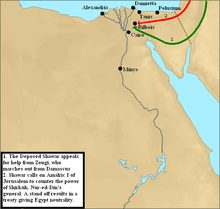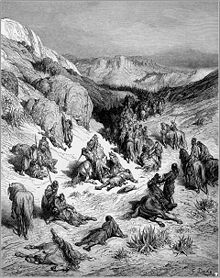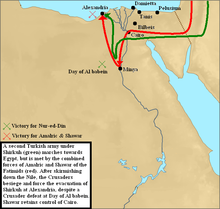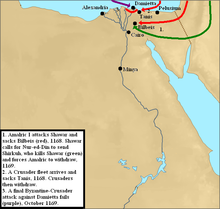
Amalric or Amaury I was King of Jerusalem from 1163, and Count of Jaffa and Ascalon before his accession. He was the second son of Melisende and Fulk of Jerusalem, and succeeded his older brother Baldwin III. During his reign, Jerusalem became more closely allied with the Byzantine Empire, and the two states launched an unsuccessful invasion of Egypt. He was the father of three future rulers of Jerusalem, Sibylla, Baldwin IV, and Isabella I.

Salah ad-Din Yusuf ibn Ayyub, commonly known as Saladin, was the founder of the Ayyubid dynasty. Hailing from a Kurdish family, he was the first sultan of both Egypt and Syria. An important figure of the Third Crusade, he spearheaded the Muslim military effort against the Crusader states in the Levant. At the height of his power, the Ayyubid realm spanned Egypt, Syria, Upper Mesopotamia, the Hejaz, Yemen, and Nubia.

Year 1169 (MCLXIX) was a common year starting on Wednesday of the Julian calendar.

The Ayyubid dynasty, also known as the Ayyubid Sultanate, was the founding dynasty of the medieval Sultanate of Egypt established by Saladin in 1171, following his abolition of the Fatimid Caliphate of Egypt. A Sunni Muslim of Kurdish origin, Saladin had originally served the Zengid ruler Nur ad-Din, leading Nur ad-Din's army in battle against the Crusaders in Fatimid Egypt, where he was made Vizier. Following Nur ad-Din's death, Saladin was proclaimed as the first Sultan of Egypt by the Abbasid Caliphate, and rapidly expanded the new sultanate beyond the frontiers of Egypt to encompass most of the Levant, in addition to Hijaz, Yemen, northern Nubia, Tarabulus, Cyrenaica, southern Anatolia, and northern Iraq, the homeland of his Kurdish family. By virtue of his sultanate including Hijaz, the location of the Islamic holy cities of Mecca and Medina, he was the first ruler to be hailed as the Custodian of the Two Holy Mosques, a title that would be held by all subsequent sultans of Egypt until the Ottoman conquest of 1517. Saladin's military campaigns in the first decade of his rule, aimed at uniting the various Arab and Muslim states in the region against the Crusaders, set the general borders and sphere of influence of the sultanate of Egypt for the almost three and a half centuries of its existence. Most of the Crusader states, including the Kingdom of Jerusalem, fell to Saladin after his victory at the Battle of Hattin in 1187. However, the Crusaders reconquered the coast of Palestine in the 1190s.

The Zengid or Zangid dynasty was an Atabegate of the Seljuk Empire created in 1127. It formed a Turkoman dynasty of Sunni Muslim faith, which ruled parts of the Levant and Upper Mesopotamia, and eventually seized control of Egypt in 1169. In 1174 the Zengid state extended from Tripoli to Hamadan and from Yemen to Sivas. Imad ad-Din Zengi was the first ruler of the dynasty.

Nūr al-Dīn Maḥmūd Zengī, commonly known as Nur ad-Din, was a member of the Zengid dynasty, who ruled the Syrian province of the Seljuk Empire. He reigned from 1146 to 1174. He is regarded as an important figure of the Second Crusade.
Following the Islamic conquest in 639, Lower Egypt was ruled at first by governors acting in the name of the Rashidun Caliphs and then the Umayyad Caliphs in Damascus, but in 747 the Umayyads were overthrown. Throughout Islamic rule, Askar was named the capital and housed the ruling administration. The conquest led to two separate provinces all under one ruler: Upper and Lower Egypt. These two very distinct regions were governed by the military and followed the demands handed down by the governor of Egypt and imposed by the heads of their communities.

Asad ad-Dīn Shīrkūh bin Shādhī, also known as Shirkuh, or Şêrko was a military commander in service of the Zengid dynasty, and uncle of Saladin. His military and diplomatic efforts in Egypt were a key factor in establishing the Ayyubid dynasty in that country.

Fustat, also Fostat, was the first capital of Egypt under Muslim rule, and the historical centre of modern Cairo. It was built adjacent to what is now known as Old Cairo by the Rashidun Muslim general 'Amr ibn al-'As immediately after the Muslim conquest of Egypt in AD 641, and featured the Mosque of Amr, the first mosque built in Egypt.
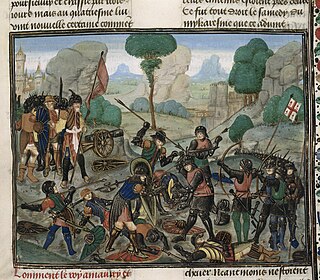
The Battle of al-Babein took place on March 18, 1167, during the third Crusader invasion of Egypt. King Amalric I of Jerusalem, and a Zengid army under Shirkuh, both hoped to take the control of Egypt over from the Fatimid Caliphate. Saladin served as Shirkuh’s highest-ranking officer in the battle. This war is Shirkuh's tactic made him win. Accordingly, the army remained at headquarters until the allied forces arrived. Shirkuh concentrated his work in the center and left Saladin Ayyubî here. To the shîrkûh army; "The Egyptian and Crusader forces will think that I am in the center and will attack with all their might. Do not engage them seriously when they attack you. Don't risk yourself by going to war, stay out of their way. When they leave you, follow them immediately. He gave his order. Shirkûh then placed the stronger men of his men on the right flank. When the war finally began, the allies attacked the center. After a small conflict, Saladin and the soldiers under his command deceived the Crusaders and retreated in an orderly manner. This pursuit of retreat by the Crusaders brought their end. Because in the meantime, Shirkuh and his entourage defeated those who remained behind. Those in the middle follow the Muslim Soldiers. When the Crusaders returned, they found their soldiers dead and were defeated. they had to retreat
Abū Muḥammad ʿAbd Allāh ibn Yūsuf ibn al-Ḥāfiẓ, better known by his regnal name al-ʿĀḍid li-Dīn Allāh, was the fourteenth and last caliph of the Fatimid dynasty, and the twenty-fourth imam of the Hafizi Isma'ili branch of Shi'a Islam, reigning from 1160 to 1171.

Gilbert of Assailly was the fifth Grand Master of the Knights Hospitaller, serving from 1162 or 1163 to 1170, when he was deposed. As Grand Master, he succeeded Auger de Balben. Nevertheless, most sources list him as the fifth, rather than fourth, Grand Master and this biography continues that tradition, with the exception being Delaville Le Roulx' work. He was succeeded by Gastone de Murols. Gilbert encouraged Amalric of Jerusalem in his unsuccessful invasion of Egypt, leaving the Order in debt and causing the reexamination of its military role.
Shawar ibn Mujir al-Sa'di was an Arab de facto ruler of Fatimid Egypt, as its vizier, from December 1162 until his assassination in 1169 by the general Shirkuh, the uncle of the future Ayyubid leader Saladin, with whom he was engaged in a three-way power struggle against the Crusader Amalric I of Jerusalem. Shawar was notorious for continually switching alliances, allying first with one side, and then the other, and even ordering the burning of his own capital city, Fustat, just so that the enemy could not have it.
Andronikos Komnenos Kontostephanos, Latinized Andronicus Contostephanus, was a major figure in the Byzantine Empire during the reign of his uncle Manuel I Komnenos as a general, admiral, politician and a leading aristocrat.
Saladin arrived in Egypt in 1163 and ruled it from 1171 until his death in 1193. Egypt was in a state of decay prior to Saladin's rise to power with the political and social situation in shambles. Saladin first arrived in Egypt alongside his uncle Shirkuh on a campaign launched by Nur al-Din. He would rise to prominence under Shirkuh eventually succeeding him as vizier of Egypt. When the Fatimid Caliphate fell in 1171, Saladin was the only remaining authority in Egypt, he would use his increased power and independence to expand his realm and influence.

In the Battle of al-Buqaia in 1163, the Crusaders and their allies inflicted a rare defeat on Nur ad-Din Zangi, the Emir of Aleppo and Damascus. King Amalric I led the army of the Kingdom of Jerusalem, together with contingents from the northern Latin states, a substantial body of pilgrims who had just arrived from France, and a force brought by the Byzantine governor of Cilicia. For the Christian forces, this victory only gave a brief respite from the sustained Muslim offensive.
Tala'i ibn Ruzzik was a military commander and official of the Fatimid Caliphate, serving as its vizier from 1154 until his assassination in 1161, when he was succeeded by his son, Ruzzik ibn Tala'i. He is generally acknowledged as the last of the powerful and capable viziers of the Fatimid state. During his tenure the Fatimid Caliphate regained a measure of stability, and was once again able to project its power abroad and pursue its political interests in the Eastern Mediterranean.

The timeline of the Kingdom of Jerusalem presents important events in the history of the Kingdom of Jerusalem—a Crusader state in modern day Israel and Jordan—in chronological order. The kingdom was established after the First Crusade in 1099. Its first ruler Godfrey of Bouillon did not take the title of king and swore fealty to the Latin Patriarch of Jerusalem, Daimbert. Godfrey's brother and successor Baldwin I was crowned the first king of Jerusalem without doing homage to the patriarch in 1100. By 1153, Baldwin I and his successors captured all towns on the Palestinian coast with the support of Pisan, Genoese and Venetian fleets and also took control of the caravan routes between Egypt and Syria. The kings regularly administered other crusader states—the Counties of Edessa and Tripoli and the Principality of Antioch—on behalf of their absent or underage rulers.
Umāra ibn Abī al-Ḥasan al-Yamanī was a historian, jurist and poet of Yemen of great repute who was closely associated with the late Fatimid Caliphate of Egypt. He was executed by order of Saladin at Cairo on April 6, 1174 for his part in a conspiracy to restore Fatimid rule. His Tarikh al-Yaman is the earliest, and in respects the most important, history of Yemen from the Islamic era.
Abu'l-Ashbāl al-Ḍirghām ibn ʿĀmir ibn Sawwār al-Lukhamī was an Arab military commander in the service of the Fatimid Caliphate. An excellent warrior and model cavalier, he rose to higher command and scored some successes against the Crusader Kingdom of Jerusalem as well as against internal rebellions. Despite his close personal ties to the viziers Tala'i ibn Ruzzik and his son Ruzzik ibn Tala'i, he joined Shawar when the latter rebelled against Ruzzik and seized the vizierate. Nine months later, Dirgham betrayed Shawar as well and expelled him from the capital, becoming vizier himself on 31 August 1163. Amidst yet another Crusader invasion in 1164, Dirgham clashed with Shawar, who had gained the support of Syrian troops led by Shirkuh. Deserted by most of his troops, Dirgham was killed sometime in May–August 1164 by Shawar's army.

